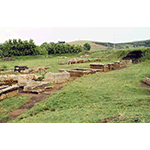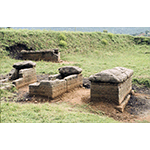Parco Archeologico di Baratti e Populonia [Archaeological Park of Baratti and Populonia]
The area of the ancient city of Populonia looks out onto the gulf of Baratti, not far from today’s Piombino. The only Etruscan centre to directly face the sea, it owed its fortune mainly to the exploitation of the iron mines of Elba Island. The raw material was transported to the slopes of the hill where the old town was located, and was worked in blast furnaces in order to obtain bars of pure iron.
We can grasp an idea of the volume of the mineral worked in Populonia in more than eight centuries (from the 9th B.C. to the 1st B.C.) from the mass of iron scoria which accumulated in time, more than one million cubic metres. This mass had ended up completely covering the Orientalising necropoli of San Cerbone and Casone.
The thirst for metal during World War I led to the reuse of the Etruscan scoria, still rich in iron material due to the imperfect ancient working process. A company was specially formed, Feromin, which in forty years (extracting activity ceased only in 1969), produced the total elimination of the remains of almost a millennium of siderurgical activity at Populonia. It was precisely by removing the scoria that the remains of monumental tholos and aedicule tombs came to light, and marked the beginning of the rediscovery of the ancient Pupluna.
Still today, beyond the walls of the city proper, near the ancient landing place, we can see the remains of the Porcareccia industrial quarter where, as of the 6th century B.C., the workshops for the transformation of ferrous materials were concentrated.
Today, the entire urban area of the ancient Populonia with its necropoli, industrial quarter and acropolis, has become an archaeological park with a detailed system of signs, which enable a thorough visit. It is also possible to participate in workshops of experimental archaeology where visitors learn the ancient techniques of working stone and ceramic.
The Archaeological Park of Baratti and Populonia is part of a vaster system of parks which extend along the coast and immediately inland. In addition to the areas of natural interest like the Parks of Ripigliano, Sterpaia and Montioni, the itinerary also includes the San Silvestro Archaeological Mines Park.
****************************
Texts by Elena Fani
English translation by Victor Beard
Last update 02/feb/2008





